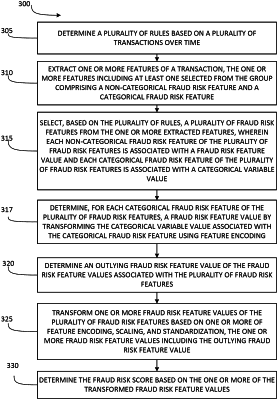| CPC G06Q 20/4016 (2013.01) [G06N 20/00 (2019.01)] | 18 Claims |

|
1. A system for determining a fraud risk score associated with a transaction, the system comprising:
a server including an electronic processor configured to:
continuously determine a plurality of rules based on a plurality of transactions over time, the plurality of rules including at least one of an anchor rule or a traffic rule,
extract a plurality of features of the transaction,
perform one or more parallelizable and tunable statistical functions in parallel with each other and in coordination with a subset of the plurality of rules that are continuously determined to select two or more fraud risk features from the plurality of features that are extracted, the subset being less than all of the plurality of rules,
wherein the two or more fraud risk features include one or more non-categorical fraud risk features and one or more categorical fraud risk features,
each of the one or more non-categorical fraud risk features of the plurality of fraud risk features is associated with a fraud risk feature value, and
each of the one or more categorical fraud risk features of the plurality of fraud risk features is associated with a categorical variable value,
determine, for the each of the one or more categorical fraud risk features of the plurality of fraud risk features, a transformed fraud risk feature value by transforming the categorical variable value associated with the one or more categorical fraud risk features using feature encoding,
determine an outlying fraud risk feature value from a plurality of fraud risk feature values,
wherein one or more fraud risk feature values and one or more transformed fraud risk feature values are part of the plurality of fraud risk feature values,
generate one or more second transformed fraud risk feature values by transforming one or more of the plurality of fraud risk feature values with one or more of feature encoding, scaling, and standardization, the plurality of fraud risk feature values including the outlying fraud risk feature value, and
determine the fraud risk score based on the one or more second transformed fraud risk feature values,
wherein the one or more parallelizable and tunable statistical functions include a number of elements that are tuned with machine learning, and
wherein the number of elements tuned by machine learning are tuned based on the fraud risk score.
|